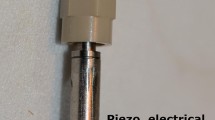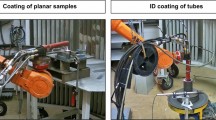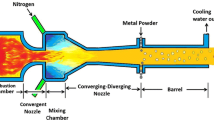Abstract
Experiments on thermal spray by pulsed detonations at 150 Hz were conducted. Two types of pulse detonation combustors were used, one operated in the inert gas purge (GAP) mode and the other in the liquid-purge (LIP) mode. In both modes, all gases were supplied in the valveless mode. The GAP mode is free of moving components, although the explosive mixture is unavoidably diluted with the inert gas used for the purge of the hot burned gas. In the LIP mode, pure fuel-oxygen combustion can be realized, although a liquid-droplet injector must be actuated cyclically. The objective of this work was to demonstrate a higher spraying temperature in the LIP mode. First, the temperature of CoNiCrAlY particles heated by pulsed detonations was measured. As a result, the spraying temperature in the LIP mode was higher than that in the GAP mode by about 1000 K. Second, the temperature of yttria-stabilized zirconia (YSZ) particles, whose melting point was almost 2800 °C, heated by pulsed detonations in the LIP mode was measured. As a result, the YSZ particles were heated up to about 2500 °C. Finally, a thermal spray experiment using YSZ particles was conducted, and a coating with low porosity was successfully deposited.













Similar content being viewed by others
Abbreviations
- a CJ :
-
Equilibrium sound speed of the burned gas in the Chapman-Jouguet state
- a g :
-
Sound speed of the gas
- C D :
-
Drag coefficient for a particle
- c pg :
-
Specific heat of the gas at constant pressure
- c s :
-
Specific heat of a particle
- D CJ :
-
Chapman-Jouguet detonation speed
- d DT :
-
Inner diameter of the detonation tube
- d s :
-
Diameter of a particle
- f :
-
Fanning friction factor
- \(f_{{n^{\prime}}} \left( {\delta_{\text{A1}} } \right)\) :
-
Function of δ A1 whose form is determined by n′
- H g :
-
Stagnation enthalpy of the burned gas
- H g,a :
-
Enthalpy of the burned gas whose temperature is equal to that of the ambient atmosphere
- k B :
-
Boltzmann constant
- L DT :
-
Length of the detonation tube
- L s :
-
Molar latent heat of fusion of the CoNiCrAlY alloy
- L s,i :
-
Molar latent heat of fusion of pure metal i
- Ma :
-
Mach number of a particle
- M CJ :
-
Propagation Mach number of the Chapman-Jouguet detonation
- M g :
-
Mach number of the gas flow
- m i :
-
Molecular mass of species i
- m s :
-
Mass of a particle
- n′:
-
Parameter determined by γ 2 as n′ = (3 − γ 2)/[2(γ 2 − 1)]
- Nu :
-
Nusselt number for a particle
- p :
-
Pressure of the gas
- p a :
-
Pressure of the ambient atmosphere
- p CJ :
-
Pressure of the burned gas in the Chapman-Jouguet state
- p plateau :
-
Gas pressure on the closed end of the detonation tube when the detonation is propagating through the detonation tube
- Pr :
-
Prandtl number
- \(\dot{Q}\) :
-
Heat flow to a particle
- Q i :
-
Time-averaged flow rate of gas i
- R a :
-
Arithmetic mean roughness of a surface
- Re :
-
Reynolds number of a particle
- Re DT :
-
Reynolds number of flow inside the detonation tube
- R u :
-
Universal gas constant
- t :
-
Time whose origin (t = 0) is the ignition timing
- t 1 :
-
Time at which the detonation is propagating at x = −0.15 m
- t 2 :
-
Time at which the detonation arrives at the PDC exit (x = 0)
- t cyc :
-
Period of cyclic PDC operation
- t exhaust :
-
Time at which the gas pressure on the closed end of the detonation tube decreases to the initial pressure
- T g :
-
Temperature of the gas
- T g,a :
-
Temperature of the ambient atmosphere
- t plateau :
-
Time at which the gas pressure on the closed end of the detonation tube begins to decrease from p plateau
- T s :
-
Temperature of a particle
- u g :
-
Flow speed of the gas
- u g,x<0 :
-
Flow speed of fresh explosive gas inside the PDC
- u s :
-
Speed of a particle
- υ CJ :
-
Specific volume of the burned gas in the Chapman-Jouguet state
- W g :
-
Average molar mass of the burned gas in the Chapman-Jouguet state
- x :
-
Coordinate along the central axis of the detonation tube, whose direction is from the closed end toward the exit and whose origin (x = 0) is at the exit
- X i :
-
Mole fraction of species i
- x s :
-
Position of a particle
- Y :
-
Mass fraction
- Y i :
-
Mass fraction of metallic component i in the CoNiCrAlY alloy
- α :
-
Heat transfer coefficient for a particle
- γ 1 :
-
Specific-heat ratio of fresh explosive gas
- γ 2 :
-
Effective specific-heat ratio of the burned gas in the Chapman-Jouguet state
- δ A1 :
-
Dimensionless quantity determined by M CJ, γ 1, and γ 2
- Δt :
-
Time step in model calculation
- ɛ DT :
-
Surface roughness of the inner wall of the detonation tube
- ɛ i :
-
Lennard-Jones potential well depth of species i
- Φ ij :
-
Dimensionless quantity used for the evaluation of the viscosity of the gas mixture
- λ g :
-
Thermal conductivity of the gas
- μ g :
-
Viscosity of the gas
- μ gs :
-
Viscosity of the gas evaluated at the particle temperature
- μ i :
-
Viscosity of pure species i
- ρ g :
-
Mass density of the gas
- ρ g,a :
-
Mass density of the burned gas whose temperature and pressure are equal to those of ambient atmosphere
- ρ s :
-
Mass density of the CoNiCrAlY alloy
- ρ s,i :
-
Mass density of pure metal i
- σ i :
-
Lennard-Jones collision diameter of species i
- τ jet :
-
Duration of the exhaust jet from the detonation tube
- Ω μi :
-
Dimensionless quantity used for the evaluation of the viscosity of pure species i
- 0:
-
Gun exit
- CJ:
-
Chapman-Jouguet
- GAP:
-
Inert gas purge
- LIP:
-
Liquid purge
- PDC:
-
Pulse detonation combustor
- PDT:
-
Pulse detonation technology
- slm:
-
Standard liter per minute
- SOFC:
-
Solid oxide fuel cell
- TBC:
-
Thermal barrier coating
- YSZ:
-
Yttria-stabilized zirconia
References
W. Fickett and W.C. Davis, Detonation, University of California Press, Berkeley, 1979
J.H.S. Lee, The Detonation Phenomenon, Cambridge University Press, New York, 2008
J.A. Nicholls, H.R. Wilkinson, and R.B. Morrison, Intermittent Detonation as a Thrust-Producing Mechanism, Jet Propul., 1957, 27(5), p 534-541
F. Schauer, J. Stutrud, and R. Bradley, Detonation Initiation Studies and Performance Results for Pulsed Detonation Engine, AIAA Paper 2001-1129, 2001.
W.H. Heiser and D.T. Pratt, Thermodynamic Cycle Analysis of Pulse Detonation Engines, J. Propul. Power, 2002, 18(1), p 68-76
G.D. Roy, S.M. Frolov, A.A. Borisov, and D.W. Netzer, Pulse Detonation Propulsion: Challenges, Current Status, and Future Perspective, Progr. Energy Combust. Sci., 2004, 30(6), p 545-672
T. Endo, J. Kasahara, A. Matsuo, K. Inaba, S. Sato, and T. Fujiwara, Pressure History at the Thrust Wall of a Simplified Pulse Detonation Engine, AIAA J., 2004, 42(9), p 1921-1930
T. Endo, T. Yatsufusa, S. Taki, A. Matsuo, K. Inaba, and J. Kasahara, Homogeneous-Dilution Model of Partially Fueled Simplified Pulse Detonation Engines, J. Propul. Power, 2007, 23(5), p 1033-1041
T. Endo, T. Yatsufusa, S. Taki, and J. Kasahara, Thermodynamic Analysis of the Performance of a Pulse Detonation Turbine Engine, Sci. Tech. Energ. Mater., 2004, 65(4), p 103-110 (in Japanese)
T. Takahashi, A. Mitsunobu, Y. Ogawa, S. Kato, H. Yokoyama, A. Susa, and T. Endo, Experiments on Energy Balance and Thermal Efficiency of Pulse Detonation Turbine Engine, Sci. Tech. Energ. Mater., 2012, 73(6), p 181-187
R.C. Tucker, Jr., Thermal spray coatings, ASM Handbook, Vol 5, Surface Engineering , C.M. Cotell, J.A. Sprague, and F.A. Smidt, Jr., Ed., ASM International, Materials Park, 1994, p 497-509
O. Knotek, Thermal Spraying and Detonation Gun Processes, Handbook of Hard Coatings, R.F. Bunshah, Ed., Noyes Publications, Park Ridge, 2001, p 77-107
P. Fauchais, A. Vardelle, and B. Dussoubs, Quo Vadis Thermal Spraying?, J. Thermal Spray Technol., 2001, 10(1), p 44-66
A.S.M. Ang, N. Sanpo, M.L. Sesso, S.Y. Kim, and C.C. Berndt, Thermal Spray Maps: Material Genomics of Processing Technologies, J. Thermal Spray Technol., 2013, 22(7), p 1170-1183
Y.A. Kharlamov, Detonation Spraying of Protective Coatings, Mater. Sci. Eng., 1987, 93, p 1-37
E.A. Astakhov, Controlling the Properties of Detonation-Sprayed Coatings: Major Aspects, Powder Metall. Met. Ceram., 2008, 47(1–2), p 70-79
Yu.A. Nikolaev, A.A. Vasil’ev, and B.Yu. Ul’yanitskii, Gas Detonation and Its Application in Engineering and Technologies (Review), Combust. Expl. Shock Waves, 2003, 39(4), p 382-410
A. Fujii, T. Akitomo, T. Okamoto, A. Susa, T. Endo, and S. Taki, High-Frequency Operation of Pulse Detonation Combustor in Valveless Mode, Proceeding of the 6th Asian-Pacific Conf. on Aerospace Technol. and Sci. (CD-ROM), Nov. 15-19, 2009 (Huangshan, China).
T. Endo, Thermal Spray by Pulsed Detonations, 2013 International Workshop on Detonation for Propulsion (USB memory), July 26-28, 2013 (Tainan, Taiwan)
K. Matsuoka, T. Mukai, and T. Endo, Development of a Liquid-Purge Method for High-Frequency Operation of Pulse Detonation Combustor, Combust. Sci. Technol., 2015, 187(5), p 747-764
P. Saravanan, V. Selvarajan, D.S. Rao, S.V. Joshi, and G. Sundararajan, Influence of Process Variables on the Quality of Detonation Gun Sprayed Alumina Coatings, Surf. Coat. Technol., 2000, 123(1), p 44-54
H. Du, W. Hua, J. Liu, J. Gong, C. Sun, and L. Wen, Influence of Process Variables on the Qualities of Detonation Gun Sprayed WC-Co Coatings, Mater. Sci. Eng. A, 2005, 408(1–2), p 202-210
C. Henkes and H. Olivier, Flow Characterization of a Detonation Gun Facility and First Coating Experiments, J. Thermal Spray Technol., 2014, 23(5), p 795-808
B.J. Gill, Super D-Gun, Aircraft Eng., 1990, 62(8), p 10-14
K. Niemi, P. Vuoristo, and T. Mäntylä, Properties of Alumina-Based Coatings Deposited by Plasma Spray and Detonation Gun Spray Processes, J. Thermal Spray Technol., 1994, 3(2), p 199-203 (Errata 3(3), p 242)
I. Fagoaga, G. Barykin, J. de Juan, T. Soroa, and C. Vaquero, The High Frequency Pulse Detonation (HFPD) Spray Process, Thermal Spray 1999: United Thermal Spray Conference, Tagungsband Conference Proceedings, E. Lugscheider and R.A. Kammer, Ed., March 17-19, 1999 (Düsseldorf, Germany), DVS Deutscher Verband für Schweißen, 1999, p 282-287.
M. Parco, G. Barykin, I. Fagoaga, and C. Vaquero, Development of Wear Resistant Ceramic Coatings by HFPD, Thermal Spray 2008: Thermal Spray Crossing Borders, E. Lugscheider, Ed., June 2-4, 2008 (Maastricht, The Netherlands), ASM International, 2008, p 130-134.
F.J. Belzunce, V. Higuera, and S. Poveda, High Temperature Oxidation of HFPD Thermal-Sprayed MCrAlY Coatings, Mater. Sci. Eng. A, 2001, 297(1–2), p 162-167
V.H. Hidalgo, F.J.B. Varela, and J.R. López, Cyclic High Temperature Oxidation of HFPD Thermal Sprayed CoNiCrAlY Coatings Under Simulated Gas Turbine and Furnace Environments, Surf. Eng., 2006, 22(4), p 277-282
M.C. Mayoral, J.M. Andrés, M.T. Bona, V. Higuera, and F.J. Belzunce, Yttria Stabilized Zirconia Corrosion Destabilization Followed by Raman Mapping, Surf. Coat. Technol., 2008, 202(21), p 5210-5216
F. Mubarok, S. Armada, I. Fagoaga, and N. Espallargas, Thermally Sprayed SiC Coatings for Offshore Wind Turbine Bearing Applications, J. Thermal Spray Technol., 2013, 22(8), p 1303-1309
V. Higuera, F.J. Belzunce, and J. Riba, Influence of the Thermal-Spray Procedure on the Properties of a CoNiCrAlY Coating, Surf. Coat. Technol., 2006, 200(18–19), p 5550-5556
V. Higuera, F.J. Belzunce, A. Carriles, and S. Poveda, Influence of the Thermal-Spray Procedure on the Properties of a Nickel-Chromium Coating, J. Mater. Sci., 2002, 37(3), p 649-654
F.J. Belzunce, V. Higuera, S. Poveda, and A. Carriles, High Temperature Oxidation of HFPD Thermal-Sprayed MCrAlY Coatings in Simulated Gas Turbine Environments, J. Thermal Spray Technol., 2002, 11(4), p 461-467
K. Tani and H. Nakahira, Status of Thermal Spray Technology in Japan, J. Thermal Spray Technol., 1992, 1(4), p 333-339
D. Soysal, J. Arnold, P. Szabo, R. Henne, and S.A. Ansar, Thermal Plasma Spraying Applied on Solid Oxide Fuel Cells, J. Thermal Spray Technol., 2013, 22(5), p 588-598
Cobalt Nickel Chromium Aluminum Yttrium (CoNiCrAlY) Thermal Spray Powders, Material Product Data Sheet, DSMTS-0092.5-CoNiCrAlY Powders, Oerlikon Metco, 2014.
Y. Hirayama, T. Matsumoto, H. Motomura, and S. Ono, Casting Method for Surface Coating, Published Unexamined Patent Application, P2004-74202A, Japan Patent Office, 2004 (in Japanese).
8% Yttria Stabilized Zirconia Agglomerated and HOSP Thermal Spray Powders, Material Product Data Sheet, DSMTS-0001.5-HOSP 8% YsZ Powders, Oerlikon Metco, 2014.
W.C. Reynolds, The Element Potential Method for Chemical Equilibrium Analysis: Implementation in the Interactive Program STANJAN, Version 3, Technical Rept., Dept. of Mechanical Engineering, Stanford Univ., 1986.
A. Haider and O. Levenspiel, Drag Coefficient and Terminal Velocity of Spherical and Nonspherical Particles, Powder Technol., 1989, 58(1), p 63-70
D.J. Carlson and R.F. Hoglund, Particle Drag and Heat Transfer in Rocket Nozzles, AIAA J., 1964, 2(11), p 1980-1984
S. Whitaker, Forced Convection Heat Transfer Correlations for Flow in Pipes, Past Flat Plates, Single Cylinders, Single Spheres, and for Flow in Packed Beds and Tube Bundles, AIChE J., 1972, 18(2), p 361-371
C. Henkes and H. Olivier, Particle Acceleration in a High Enthalpy Nozzle Flow with a Modified Detonation Gun, J. Thermal Spray Technol., 2014, 23(4), p 625-640
L.L. Kavanau and R.M. Drake, Jr., Heat Transfer from Spheres to a Rarefied Gas in Subsonic Flow, Technical Rept., HE-150-108, Univ. of California, 1953.
R.B. Bird, W.E. Stewart, and E.N. Lightfoot, Transport Phenomena, Sec. 1.4, 2nd ed., Wiley, New York, 2002
C.K. Law, Combustion Physics, Ch. 4, Cambridge University Press, New York, 2006
R.S. Brokaw, Predicting Transport Properties of Dilute Gases, Ind. Eng. Chem. Process Des. Dev., 1969, 8(2), p 240-253
B.E. Poling, J.M. Prausnitz, and J.P. O’Connell, The Properties of Gases and Liquids, 5th ed., McGraw-Hill, New York, 2001, p 10.3
T. Fujii and T. Takahashi, Estimation of Thermophysical Properties of Coating Layers for Gas Turbine Hot Parts—Part 1: Measurement of Thermophysical Properties of Coating Layers and Superalloy, and Comparison between Virgin and Aged Material—, CRIEPI REPORT, W97017, Central Research Institute of Electric Power Industry, 1998 (in Japanese).
E. Romeo, C. Royo, and A. Monzón, Improved Explicit Equations for Estimation of the Friction Factor in Rough and Smooth Pipes, Chem. Eng. J., 2002, 86(3), p 369-374
P.O. Witze, Centerline Velocity Decay of Compressible Free Jets, AIAA J., 1974, 12(4), p 417-418
G. Kleinstein, Mixing in Turbulent Axially Symmetric Free Jets, J. Spacecr., 1964, 1(4), p 403-408
I. Fagoaga, M. Parco, G. Barykin, C. Vaquero, and J. de Juan, Development of Zirconia Coatings by HFPD, Thermal Spray 2006: International Thermal Spray Conference, B.R. Marple, M.M. Hyland, Y.-C. Lau, R.S. Lima, and J. Voyer, Ed., May 15-18, 2006 (Seattle, USA), ASM International, 2006, p 551-556.
A.R. Nicoll and A. Salito, The Potential of Plasma Spraying for the Deposition of Coatings on SOFC Components, Solid State Ionics, 1992, 52(1–3), p 269-275
Acknowledgment
This work was supported by KAKENHI 26289323 and JKA 25-148.
Author information
Authors and Affiliations
Corresponding author
Rights and permissions
About this article
Cite this article
Endo, T., Obayashi, R., Tajiri, T. et al. Thermal Spray Using a High-Frequency Pulse Detonation Combustor Operated in the Liquid-Purge Mode. J Therm Spray Tech 25, 494–508 (2016). https://doi.org/10.1007/s11666-015-0354-8
Received:
Revised:
Published:
Issue Date:
DOI: https://doi.org/10.1007/s11666-015-0354-8




